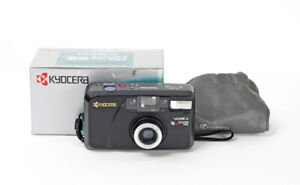

Here are some photos that other people have taken with this model of camera in its various names: The camera is in very good aesthetic condition (see photos). We verified the film plane focus accuracy with an auto-collimator. We tested the camera with batteries and film installed (we did not develop the film) and all features are working correctly. The camera requires two normal AA batteries (not included). It was sold by a number of other names including Kyocera Campus 70, Yashica EZS Zoom 70 and Yashica Zoomate 70.

In 2005, Kyocera announced it would cease production of all Yashica, Kyocera, and Contax cameras.The Yashica Elite Zoom 70 is very nice 35mm from the company's Kyocera era (when the company developed the famed T4 and T5 models). A new medium-format film camera, the Contax 645 AF, appeared in 1999, along with several dedicated and interchangeable lenses. The company also entered the digital camera field in 1997 with Kyocera, Yashica, and Contax branded models. These include the 35mm Contax G and Contax G2 rangefinders, and the Contax N-series of autofocus SLRs. Kyocera continued to make point-and-shoot film cameras under its own name and that of Yashica, as well as premium rangefinder and SLR models.
YASHICA EZS ZOOM 70 SERIES
Kyocera's last series of 35mm Yashica SLRs, the 107/ 108/ 109MP line, was not a commercial success, though the old Yashica FX-3 (now in Super 2000 form) sold well until its discontinuance in 2002. Kyocera had also continued the process of repositioning Yashica SLR cameras, offshoring assembly to China and Hong Kong to reduce costs. This compact camera was equipped with a high-quality 35mm/3.5 Carl Zeiss T* lens along with improved weather sealing, and proved very popular as a rugged travel camera. Kyocera also made a number of fairly successful autofocus point-and-shoot film cameras for the consumer market, culminating in 1992 with the Yashica T4. The Yashica autofocus SLR cameras continued in a progressively cheapened series of models until 1994, when the entire autofocus line was discontinued, reportedly after significant losses. Kyocera attempted to encourage existing owners of Yashica manual-focus SLR cameras to move to autofocus by offering a 1.6x tele-converter adapter to mount Yashica or Contax MF lenses to the autofocus cameras, but without much success. Furthermore, the attractive range of Contax Carl Zeiss T* lenses was no longer an option, as there were no new Contax lenses in the new Yashica autofocus mount. The Samurai Z was even available in a lefthanders' version (Samurai Z-L). These zoom cameras were optimized for one-hand operation.


A little better success was achieved with the Samurai series of compact SLRs in camcorder design. Unfortunately, the new Yashica AF cameras were introduced rather late and had difficulty against more established competition, which also had a larger selection of compatible lenses. In December 1986, Kyocera introduced its new line of autofocus 35mm SLR cameras and lenses, all but one carrying the Yashica name for the international market. The company also decided to manufacture an AF 35mm SLR camera and a new series of AF lenses to compete with Minolta's revolutionary Maxxum/Dynax. Kyocera also began to offer various cameras with the Kyocera nameplate for buyers in Japan, while subsuming the old Yashica into its new corporate identity. Kyocera decided to reposition the entire Yashica manual-focus SLR line as a ‘value-priced’ choice for entry-level photographers. However, the 1985 introduction of Minolta's Maxxum/Dynax 7000 autofocus (AF) camera was a huge success, and all camera makers scrambled to catch up. Both brands continued to feature the same C/Y bayonet lens mount, allowing owners of less expensive Yashica cameras to use all of the Contax/Yashica lenses, including the premium Contax Zeiss T* lenses.
YASHICA EZS ZOOM 70 FULL
The manual-focus (MF) FX-103 Program, introduced in 1985, continued the ‘pairing’ tradition of Yashica SLR models with those of Contax (Contax 159mm), and featured TTL flash and full programmed exposure capabilities. Initially, the company continued to produce evolutionary camera designs under the Yashica and Contax brands, such as the Yashica FX-3 and Contax 159MM. It changed its name to Kyocera (京セラ株式会社) in 1982, and became involved in camera production in October 1983, when it acquired Yashica Company Ltd. Kyocera, originally a ceramics manufacturer, was founded in 1959 as Kyoto Ceramic Co.


 0 kommentar(er)
0 kommentar(er)
